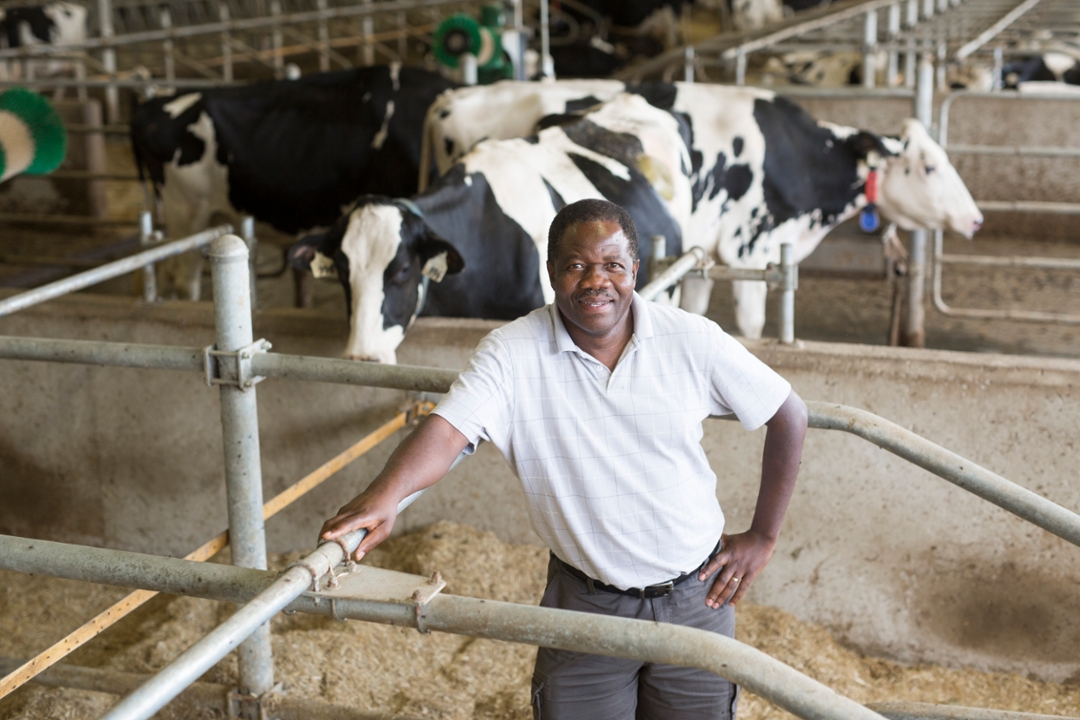
An incredible journey
A life-long passion takes animal nutrition researcher to the far edge of inner space.
By Glenn CheaterIf improving feed efficiency in cattle sounds a little dull, take a few steps down the road Tim Mutsvangwa has travelled. It’s quite a journey.
It starts in the 1970s in a tiny village in Zimbabwe where centuries’ old practices still reigned; passes through an era of research that once seemed high tech but is now antiquated itself; and then into the depths of inner space where the secrets of a can-you-believe-it molecular dance are being laid bare.
Mutsvangwa grew up in Harare, but spent school holidays in the village of Mureverwi, helping his mother with chores such as milking indigenous Zebu cows.
“These are draft animals and produce very little milk—just enough for household consumption,” recalled the professor of ruminant nutrition and metabolism, who came to U of S in 2003.
Since it was all he knew, Mutsvangwa assumed three to six litres of daily milk production was normal. He was astonished when he learned Holsteins produce north of 30 litres.
“When I realized that some cows were producing so much more, I was very intrigued,” he said. “I wanted to know what’s the difference between the cows I’m milking now and those cows. So I became interested in genetics and nutrition, and that’s what got me into animal science and animal nutrition.”
At the University of Zimbabwe, Mutsvangwa quickly learned there was one place above all others—the Rowett Research Institute in Aberdeen, Scotland—for a young man eager to learn the science of animal nutrition.
“My teachers had been trained at the University of Aberdeen and they used to talk about these big names—we would read papers published by these big names and use textbooks they had written,” he said.
When he won a British Council Scholarship, there was no question where he wanted to go.
“All of a sudden these big names were my instructors—it was quite inspiring,” he says before adding with a laugh, “I actually had one of them autograph a textbook he wrote. I still have it—it’s sitting on a shelf in my office.”
But while the work was groundbreaking, feed efficiency research in those days was largely limited to feed and weigh trials. High-tech meant assessing feed digestion via fistulated cows (in which a surgically placed and removable plug gives access to the rumen, the first of a cow’s four stomach chambers). Again, a lot was learned from this technique, but research technology in biology has rocketed far, far beyond that.
While Mutsvangwa was doing his PhD in Guelph, previously unknown protein molecules were discovered in the tissues of humans and other mammals that would become the focus of his work. Urea transporters are prime examples of the marvellous ingenuity of Mother Nature. It’s long been known that microbes in the gut produce ammonia, which is toxic, and that the liver converts it to benign urea, which is then moved to the kidneys and whisked out of the body in urine.
But the burning question was: How? How did urea pass through the liver membrane, the walls of blood vessels, and into the kidneys? The discovery of urea transporters (there are several groups of them) would give scientists the answer, albeit one that’s hard for non-scientists to imagine.
When asked for a layman’s description, Mutsvangwa laughs again.
“You’re putting me on the spot here,” he says. “They’re basically proteins and because of their amino acid composition, they have a certain shape when expressed in different tissues. They also have receptors that attract whatever molecule they’re supposed to transport across certain types of cell membranes.”
Imagine an intricately shaped grappling hook designed so that only one type of molecule will ‘fit’ into it. This particular device can lock onto a urea molecule, move it out of the liver, and into the bloodstream and then into the kidney. Once there, it changes shape, causing the urea molecule to be released.
It’s all part of a larger system with a simple purpose: Take a poison (ammonia), turn it into something harmless (urea), and then get it out of the body as efficiently as possible.
But since discovering urea transporters, researchers have found something rather bizarre in cattle and other ruminants—they’ve turned the system on its head by using this waste product to produce milk, grow fetuses and build muscle.
“Ruminants are faced with times when nitrogen in their diets is very deficient,” said Mutsvangwa. “They have evolved a way to take urea from the bloodstream and recycle it. There are types of transporters that move urea into the digestive tract where it is used by microbes to produce amino acids. Those amino acids are then recovered when the microbes are digested.
“Basically it allows the animal to have a second, third, and fourth opportunity to use nitrogen that would otherwise be excreted.”
It’s a very neat trick, and one that Mutsvangwa and his team want to exploit.
“This is just me thinking well into the future,” he said. “But once we have a good grasp on how these urea transporters and aquaporins (another membrane transport protein) are controlled, then we can maybe manipulate the expression (number) of them. And the more of them you have, the less urea in the urine. That has an obvious environmental benefit and, at the same time, you improve feed efficiency.”
The latter, by the way, is pretty dismal—70 per cent to 85 per cent of the protein fed to cattle ends up in manure or urine. But it’s now conceivable that one day, Mutsvangwa or those following in his footsteps may dramatically alter that equation by developing a feed additive that greatly boosts the number of these transport proteins and their recycling ways.
It sounds like science fiction, but the scientist who once milked Zebus knows full well that just because something is unimaginable doesn’t mean it’s not possible.

